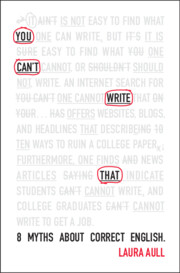Book contents
- You Can’t Write That
- You Can’t Write That
- Copyright page
- Dedication
- Contents
- Figures
- Tables
- Acknowledgements
- Introduction: When Writing Means Correct Writing
- Chapter One Myth 1 You Can’t Write That
- Chapter Two Myth 2 You Can’t Write That in School
- Chapter Three Myth 3 You Can’t Write That and Be Smart
- Chapter Four Myth 4 You Can’t Write That on the Test
- Chapther Five Myth 5 Chances Are, You Can’t Write
- Chapter Six Myth 6 You Can’t Write if You Didn’t Write Well in High School
- Chapter Seven Myth 7 You Can’t Get a Job if You Didn’t Write Well in College
- Chapter Eight Myth 8 You Can’t Write That Because Internet
- Chapter Nine Conclusion: Writing Continuum, Language Exploration
- Afterword
- Notes
- References
- Index
- References
References
Published online by Cambridge University Press: 09 November 2023
- You Can’t Write That
- You Can’t Write That
- Copyright page
- Dedication
- Contents
- Figures
- Tables
- Acknowledgements
- Introduction: When Writing Means Correct Writing
- Chapter One Myth 1 You Can’t Write That
- Chapter Two Myth 2 You Can’t Write That in School
- Chapter Three Myth 3 You Can’t Write That and Be Smart
- Chapter Four Myth 4 You Can’t Write That on the Test
- Chapther Five Myth 5 Chances Are, You Can’t Write
- Chapter Six Myth 6 You Can’t Write if You Didn’t Write Well in High School
- Chapter Seven Myth 7 You Can’t Get a Job if You Didn’t Write Well in College
- Chapter Eight Myth 8 You Can’t Write That Because Internet
- Chapter Nine Conclusion: Writing Continuum, Language Exploration
- Afterword
- Notes
- References
- Index
- References
Summary
- Type
- Chapter
- Information
- You Can't Write That8 Myths About Correct English, pp. 189 - 223Publisher: Cambridge University PressPrint publication year: 2023
- Creative Commons
- This content is Open Access and distributed under the terms of the Creative Commons Attribution licence CC-BY-NC-ND 4.0 https://creativecommons.org/cclicenses/



